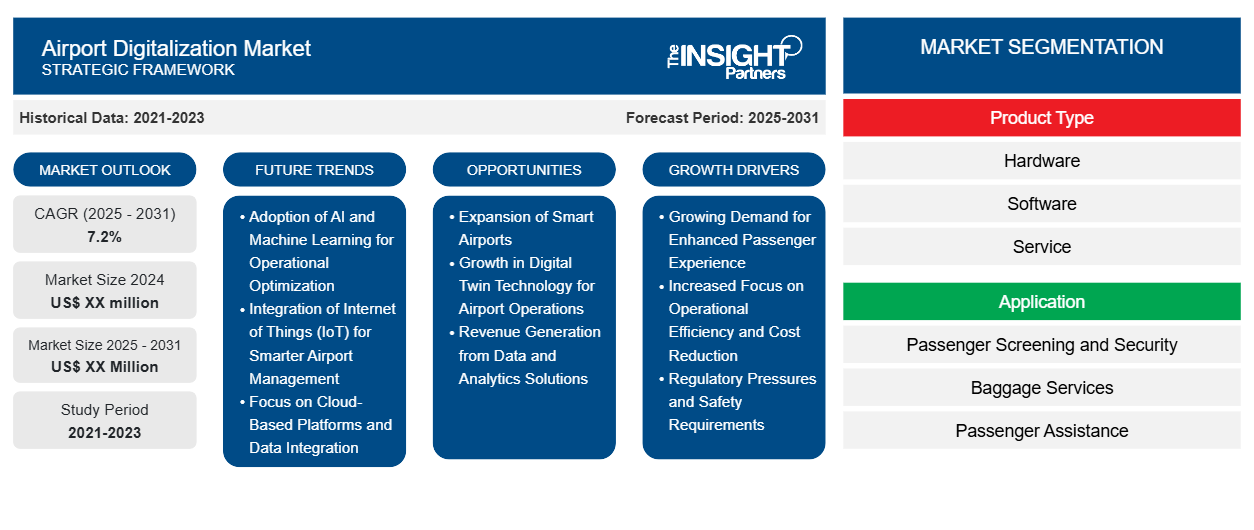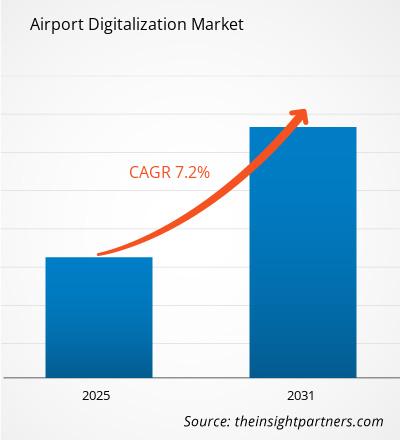The Airport Digitalization Market is expected to register a CAGR of 7.2% from 2025 to 2031, with a market size expanding from US$ XX million in 2024 to US$ XX Million by 2031.
The report is segmented by By Product Type (Hardware, Software, Service). The report further presents analysis based on the Application (Passenger Screening and Security, Baggage Services, Passenger Assistance, Others). The global analysis is further broken-down at regional level and major countries. The Report Offers the Value in USD for the above analysis and segments.
Purpose of the Report
The report Airport Digitalization Market by The Insight Partners aims to describe the present landscape and future growth, top driving factors, challenges, and opportunities. This will provide insights to various business stakeholders, such as:
- Technology Providers/Manufacturers: To understand the evolving market dynamics and know the potential growth opportunities, enabling them to make informed strategic decisions.
- Investors: To conduct a comprehensive trend analysis regarding the market growth rate, market financial projections, and opportunities that exist across the value chain.
- Regulatory bodies: To regulate policies and police activities in the market with the aim of minimizing abuse, preserving investor trust and confidence, and upholding the integrity and stability of the market.
Airport Digitalization Market Segmentation
Product Type
- Hardware
- Software
- Service
Application
- Passenger Screening and Security
- Baggage Services
- Passenger Assistance
- Others
Customize This Report To Suit Your Requirement
You will get customization on any report - free of charge - including parts of this report, or country-level analysis, Excel Data pack, as well as avail great offers and discounts for start-ups & universities
Airport Digitalization Market: Strategic Insights

- Get Top Key Market Trends of this report.This FREE sample will include data analysis, ranging from market trends to estimates and forecasts.
Airport Digitalization Market Growth Drivers
- Growing Demand for Enhanced Passenger Experience: As passenger expectations evolve, airports are increasingly focusing on improving the overall travel experience through digitalization. Solutions like biometric check-ins, mobile ticketing, self-service kiosks, and smart baggage handling systems are becoming commonplace. These technologies streamline the passenger journey, reduce wait times, and improve customer satisfaction. The need to offer a seamless, personalized, and more efficient airport experience is a key driver of digital transformation in the aviation sector, pushing airports to adopt innovative digital solutions.
- Increased Focus on Operational Efficiency and Cost Reduction: Airports are under constant pressure to reduce operational costs while maintaining or improving service levels. Digital technologies, such as IoT, big data analytics, and cloud-based systems, enable airports to optimize operations, enhance resource management, and improve operational efficiency. For example, predictive maintenance systems can help reduce downtime by identifying equipment failures before they occur, and data analytics tools enable more efficient flight scheduling and airport resource allocation. The drive for cost savings and operational efficiency is accelerating digital adoption in airports.
- Regulatory Pressures and Safety Requirements: Increasing regulatory requirements surrounding passenger safety, security, and data privacy are pushing airports to adopt digital technologies to comply with new standards. For instance, biometric security checks, AI-based surveillance, and automated systems for passenger screening are becoming more critical in meeting the stringent requirements set by regulatory bodies such as the International Civil Aviation Organization (ICAO). Additionally, airports need to meet emerging data protection laws, like GDPR, which can be streamlined through digital systems, further driving the digitalization trend
Airport Digitalization Market Future Trends
- Adoption of AI and Machine Learning for Operational Optimization: One of the key trends in the airport digitalization market is the adoption of artificial intelligence (AI) and machine learning (ML) technologies to optimize airport operations. AI is being utilized for a variety of functions, including predictive maintenance, dynamic resource allocation, and real-time traffic management. Machine learning algorithms can analyze vast amounts of data from various sources to predict flight delays, optimize check-in processes, and enhance crowd management. These technologies improve efficiency, reduce costs, and enhance passenger experience, driving further investment in digital solutions.
- Integration of Internet of Things (IoT) for Smarter Airport Management: IoT-based solutions are playing an increasingly significant role in airport digitalization. Sensors embedded in airport infrastructure, such as terminals, baggage systems, and aircraft ground services, collect real-time data that is then analyzed to enhance operational efficiency. For example, IoT sensors help monitor air quality, track baggage movement, and improve baggage handling and tracking systems. The use of connected devices for managing airport assets and resources is a growing trend that enhances visibility, enables data-driven decision-making, and improves the overall passenger experience by reducing delays and ensuring smoother airport operations.
- Focus on Cloud-Based Platforms and Data Integration: Cloud-based platforms are becoming integral to airport digitalization, enabling better data integration and collaboration across various airport departments. Cloud solutions allow airports to centralize their data and provide real-time access to relevant stakeholders, including airlines, ground services, security teams, and retail vendors. By consolidating data, airports can make faster, more informed decisions, enhance communication, and improve service delivery. Cloud-based technologies also support scalability, making it easier for airports to adopt new technologies or expand services without the limitations of on-premises infrastructure, driving the trend toward cloud adoption
Airport Digitalization Market Opportunities
- Expansion of Smart Airports: The development of "smart airports" presents a huge opportunity in the digitalization market. Airports are increasingly adopting advanced technologies such as biometric identification, facial recognition, AI-powered chatbots, and self-service kiosks to create more efficient, personalized, and secure passenger experiences. The ongoing trend of integrating smart technologies in airport terminals, air traffic management, and baggage handling systems is expected to accelerate as airports aim to become more sustainable, efficient, and customer-centric. As more airports undergo digital transformation, there is substantial market potential for technology providers that specialize in these innovations.
- Growth in Digital Twin Technology for Airport Operations: The use of digital twin technology is emerging as a key opportunity in the airport digitalization market. A digital twin is a virtual representation of the airport infrastructure and its operations, created using real-time data collected from IoT devices, sensors, and cameras. This digital replica allows airport operators to simulate, monitor, and optimize real-time airport operations, including passenger flow, baggage handling, and air traffic management. The growing interest in digital twin technology as a tool for enhancing operational efficiency, improving safety, and facilitating proactive decision-making is presenting new opportunities for providers of simulation and modeling technologies.
- Revenue Generation from Data and Analytics Solutions: As airports become more digitally connected, there is an opportunity to monetize the vast amounts of data generated through passenger interactions, operational activities, and environmental monitoring. Airlines, retail operators, and third-party service providers can leverage this data to gain insights into customer behavior, optimize service offerings, and improve revenue streams. Additionally, airports can use analytics platforms to enhance operational performance, forecast passenger traffic, and streamline capacity management. The growing emphasis on data-driven decision-making opens up opportunities for technology companies to offer data analytics and business intelligence solutions tailored to the aviation sector
Airport Digitalization Market Regional Insights
The regional trends and factors influencing the Airport Digitalization Market throughout the forecast period have been thoroughly explained by the analysts at Insight Partners. This section also discusses Airport Digitalization Market segments and geography across North America, Europe, Asia Pacific, Middle East and Africa, and South and Central America.

- Get the Regional Specific Data for Airport Digitalization Market
Airport Digitalization Market Report Scope
| Report Attribute | Details |
|---|---|
| Market size in 2024 | US$ XX million |
| Market Size by 2031 | US$ XX Million |
| Global CAGR (2025 - 2031) | 7.2% |
| Historical Data | 2021-2023 |
| Forecast period | 2025-2031 |
| Segments Covered |
By Product Type
|
| Regions and Countries Covered | North America
|
| Market leaders and key company profiles |
Airport Digitalization Market Players Density: Understanding Its Impact on Business Dynamics
The Airport Digitalization Market market is growing rapidly, driven by increasing end-user demand due to factors such as evolving consumer preferences, technological advancements, and greater awareness of the product's benefits. As demand rises, businesses are expanding their offerings, innovating to meet consumer needs, and capitalizing on emerging trends, which further fuels market growth.
Market players density refers to the distribution of firms or companies operating within a particular market or industry. It indicates how many competitors (market players) are present in a given market space relative to its size or total market value.
Major Companies operating in the Airport Digitalization Market are:
- Microsoft Corporation
- IBM
- Cisco Systems Inc.
- Siemens AG
- SAP SE
Disclaimer: The companies listed above are not ranked in any particular order.

- Get the Airport Digitalization Market top key players overview
Key Selling Points
- Comprehensive Coverage: The report comprehensively covers the analysis of products, services, types, and end users of the Airport Digitalization Market, providing a holistic landscape.
- Expert Analysis: The report is compiled based on the in-depth understanding of industry experts and analysts.
- Up-to-date Information: The report assures business relevance due to its coverage of recent information and data trends.
- Customization Options: This report can be customized to cater to specific client requirements and suit the business strategies aptly.
The research report on the Airport Digitalization Market can, therefore, help spearhead the trail of decoding and understanding the industry scenario and growth prospects. Although there can be a few valid concerns, the overall benefits of this report tend to outweigh the disadvantages.
- Historical Analysis (2 Years), Base Year, Forecast (7 Years) with CAGR
- PEST and SWOT Analysis
- Market Size Value / Volume - Global, Regional, Country
- Industry and Competitive Landscape
- Excel Dataset


- Glycomics Market
- Batter and Breader Premixes Market
- Radiopharmaceuticals Market
- Single-Use Negative Pressure Wound Therapy Devices Market
- Social Employee Recognition System Market
- Aerosol Paints Market
- Analog-to-Digital Converter Market
- Sweet Potato Market
- Water Pipeline Leak Detection System Market
- Investor ESG Software Market

Report Coverage
Revenue forecast, Company Analysis, Industry landscape, Growth factors, and Trends

Segment Covered
This text is related
to segments covered.

Regional Scope
North America, Europe, Asia Pacific, Middle East & Africa, South & Central America

Country Scope
This text is related
to country scope.
Frequently Asked Questions
Some of the customization options available based on the request are an additional 3-5 company profiles and country-specific analysis of 3-5 countries of your choice. Customizations are to be requested/discussed before making final order confirmation, as our team would review the same and check the feasibility.
The report can be delivered in PDF/PPT format; we can also share excel dataset based on the request.
The leading players operating in the Airport Digitalization Market include IBM Corporation, Microsoft Corporation, Cisco Systems Inc, Siemens Energy, SAP SE, Capgemini, Scarabee Aviation Group BV, Daifuku Co Ltd, Airbus SE, Oracle Corporation
The Airport Digitalization Market is estimated to witness a CAGR of 7.2% from 2023 to 2031
Rise in Demand for Automation and Focus on Data-Driven Decision-Making is the key future trend of the Airport Digitalization Market
The major factors driving the Airport Digitalization Market are: Enhanced Passenger Experience and Operational Efficiency and Cost Savings
Trends and growth analysis reports related to Aerospace and Defense : READ MORE..
1. Microsoft Corporation
2. IBM
3. Cisco Systems Inc.
4. Siemens AG
5. SAP SE
6. Capgemini
7. Scarabee Aviation Group B.V.
8. Siemens
9. Daifuku Co., Ltd.
10. SITA

 Get Free Sample For
Get Free Sample For